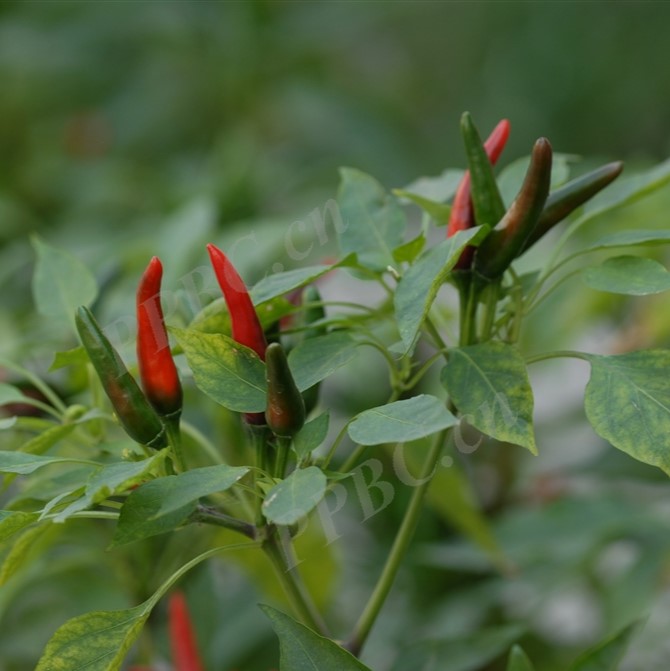Capsicum annuum
Overview
| Genus | Capsicum |
| Species | annuum |
| Common Name | Paprika, chili pepper, jalapeño, cayenne, bell pepper |
| Abbreviation | C. annuum |
| Ploidy | Diploid |
| Chromosome Number | 2n = 24 |
| Genome Size | 3070-3480 Mb |
| Genome Assemblies | 25 |
| Cross Reference | NCBI taxon: 4072 |
Organism Image

Description
Capsicum annuum is a fruiting plant from the family Solanaceae (nightshades), within the genus Capsicum which is native to northern region of South America, and southwestern North America. The plant produces berries of many colors including red, green, and yellow, often with pungent taste. It also has many varieties and common names including paprika, chili pepper, jalapeño, cayenne, bell pepper, and many more with over 200 variations within the species. It is also one of the oldest cultivated crops, with domestication dating back to around 6,000 years ago in regions of Mexico. The genus Capsicum has over 30 species but Capsicum annuum is the primary species in its genus, as it has been widely cultivated for human consumption for a substantial amount of time and has spread across the world. This species has many uses in culinary applications, medicinal uses, self defense, and can even be ornamental. With high levels of cultivation the species is cared for greatly and globaly, though there are still some pests and diseases that can impact the species.
Whole Genomes
Whole Genome Sequences & Annotations for Capsicum annuum
S genes
Capsicum annuum 'UCD-10X-F1 (Cultivar)' UCD10Xv1.1 S genes
| Query | Chromosome | Size(bp) | Coordinates | BLASTn Hit | BLASTn %ID | Domain |
| SLF18 | CM009386.1 | 255,602,192 | 189755843-189756988 | Solanum tuberosum DM8.1, SLF18-2 | 84.1 | F-box domain |
Downloads
The Capsicum annuum S gene sequences are available in FASTA format.
| CDS and Protein (FASTA file) | S-gene_Capsicum_annuum |
Publications
Hulse-Kemp AM, Maheshwari S, Stoffel K, Hill TA, Jaffe D, Williams SR, Weisenfeld N, Ramakrishnan S, Kumar V, Shah P, Schatz MC, Church DM, Van Deynze A. Reference quality assembly of the 3.5-Gb genome of Capsicum annuum from a single linked-read library. Hortic Res. 2018 Jan 12;5:4. doi: 10.1038/s41438-017-0011-0.
Kim S, Park M, Yeom SI, Kim YM, Lee JM, Lee HA, Seo E, Choi J, Cheong K, Kim KT, Jung K, Lee GW, Oh SK, Bae C, Kim SB, Lee HY, Kim SY, Kim MS, Kang BC, Jo YD, Yang HB, Jeong HJ, Kang WH, Kwon JK, Shin C, Lim JY, Park JH, Huh JH, Kim JS, Kim BD, Cohen O, Paran I, Suh MC, Lee SB, Kim YK, Shin Y, Noh SJ, Park J, Seo YS, Kwon SY, Kim HA, Park JM, Kim HJ, Choi SB, Bosland PW, Reeves G, Jo SH, Lee BW, Cho HT, Choi HS, Lee MS, Yu Y, Do Choi Y, Park BS, van Deynze A, Ashrafi H, Hill T, Kim WT, Pai HS, Ahn HK, Yeam I, Giovannoni JJ, Rose JK, Sørensen I, Lee SJ, Kim RW, Choi IY, Choi BS, Lim JS, Lee YH, Choi D. Genome sequence of the hot pepper provides insights into the evolution of pungency in Capsicum species. Nat Genet. 2014 Mar;46(3):270-8. doi: 10.1038/ng.2877.
Qin C, Yu C, Shen Y, Fang X, Chen L, Min J, Cheng J, Zhao S, Xu M, Luo Y, Yang Y, Wu Z, Mao L, Wu H, Ling-Hu C, Zhou H, Lin H, González-Morales S, Trejo-Saavedra DL, Tian H, Tang X, Zhao M, Huang Z, Zhou A, Yao X, Cui J, Li W, Chen Z, Feng Y, Niu Y, Bi S, Yang X, Li W, Cai H, Luo X, Montes-Hernández S, Leyva-González MA, Xiong Z, He X, Bai L, Tan S, Tang X, Liu D, Liu J, Zhang S, Chen M, Zhang L, Zhang L, Zhang Y, Liao W, Zhang Y, Wang M, Lv X, Wen B, Liu H, Luan H, Zhang Y, Yang S, Wang X, Xu J, Li X, Li S, Wang J, Palloix A, Bosland PW, Li Y, Krogh A, Rivera-Bustamante RF, Herrera-Estrella L, Yin Y, Yu J, Hu K, Zhang Z. Whole-genome sequencing of cultivated and wild peppers provides insights into Capsicum domestication and specialization. Proc Natl Acad Sci U S A. 2014 Apr 8;111(14):5135-40. doi: 10.1073/pnas.1400975111.
Esposito S, Aiese Cigliano R, Cardi T, Tripodi P. Whole-genome resequencing reveals genomic footprints of Italian sweet and hot pepper heirlooms giving insight into genes underlying key agronomic and qualitative traits. BMC Genom Data. 2022 Mar 25;23(1):21. doi: 10.1186/s12863-022-01039-9.